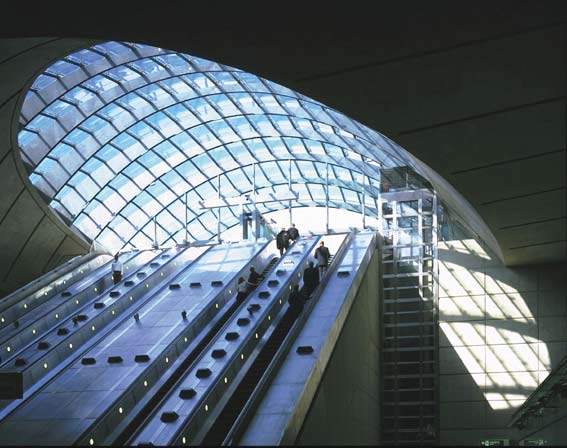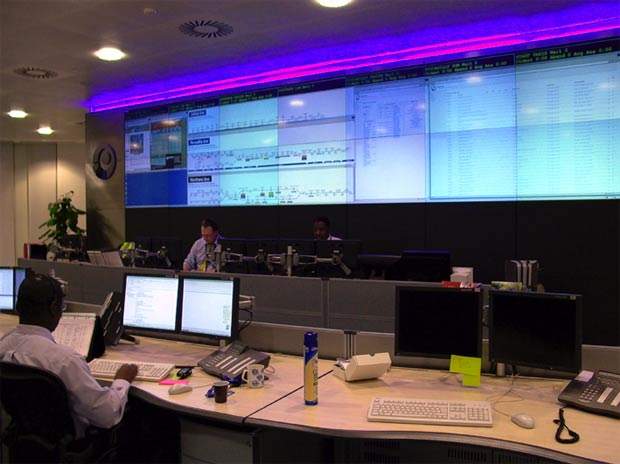Construction of the extension of London Underground’s Jubilee Line from Green Park, through south London and Docklands to Stratford, proved a troublesome project.
The original spring 1998 target opening date slipped back largely due to problems with associated tunnelling on the first phase, which cuts under some of the busiest parts of the English capital. Nevertheless, it opened throughout on 22 December 1999, and will form an important transport artery to the Olympic Games in 2012.
The Jubilee Line set the pattern for future investment in the network, with increasing involvement of private finance. It is operated by London Underground and maintained by Tube Lines.
The initial Jubilee Line opened on 1 May 1979, linking up the then most recent sections of Underground, the 4km (2.5 miles) of twin tunnels between Baker Street and Charing Cross, with the former Bakerloo Line branch between Baker Street and Stanmore. Approval for a further Jubilee Line extension was gained in March 1992.
The project
Costing a total of £3.5bn when completed, the project had been expected to take just under three years to complete. The opening of the new route also saw the diversion of the Jubilee Line away from its original terminus at Charing Cross, with the new line running from Green Park to Westminster, Waterloo and on eastwards to a new terminus at Stratford.
The route serves the growing business and media communities around Canary Wharf, while nearby, at north Greenwich, the largest station on the new section has been built to serve the Millennium Dome attraction.
Tube Lines is investing heavily in refurbishing stations ahead of the Olympic Games, and also working on the rest of the Jubilee Line to improve the standard throughout.
Tube Lines anticipated 17 months for the closure of several lines including the Northern Line. In January 2010, an arbitrator concluded and rejected the claim of Tube Lines for £327m from Transport for London (TfL), due to the delay in upgrading the Jubilee and Northern lines. The Jubilee Line upgrade is now scheduled to be completed in October 2010.
Tube Lines will minimise the inconvenience to passengers by enhancing efficiency using extended engineering hours.
Infrastructure
The extension is 10 miles (16km) long. Infrastructure improvements on the existing route give potential capacity for 27 trains per hour, seven more than the original scheduled peak service.
Some technical problems were encountered, but the collapse of a tunnel during work on the extension of the Heathrow Express’s NATM tunnel to the airport led to a temporary halt in Jubilee Line work The modernisation of tunnels at Waterloo and London Bridge raised the overall forecast cost by £190m. Great care also had to be exercised under the centre of London, where the safety of over 30 structures had to be ensured, including the Government’s Treasury headquarters, the Ritz Hotel, and also St James Park close to Buckingham Palace.
The 3.7km stretch at the eastern end of the line, between Canning Town and Stratford, is the longest section not in tunnel. However, in the double-deck Canning Town station, and the vast complex at Stratford Market where the new train fleet is based and maintained, it boasts two of the most distinctive buildings of the whole project.
This section also boasts some very busy interchanges. At Stratford, for example, the line intersects with the Docklands Light Railway, LU’s Central Line, heavy rail routes from East Anglia and east London into Liverpool Street, and the North London Line.
Rolling stock
Services on the line are operated by new trains built by Alstom in Birmingham. The bodyshells are built of extruded aluminium, and designed to be very strong yet comparatively light.
Their weight is kept down further by the use of ac rather than dc motors, which is also expected to make maintenance easier. The trains are equipped for automatic train control (ATC) operation, with a maximum design speed of 100km/h (60mph).
Four additional new trains entered service in 2006 and all have been strengthened to seven coach formations, which also forced changes to on-station CCTV, signalling and platform edge doors. This increase in capacity allows an extra 6,000 passengers per hour to board Jubilee Line trains at peak times.
Network signalling and communications
A new signalling system was installed on the Jubilee Line in January 2009, three years before the Olympic Games. The £600m scheme (which includes the Northern Line too) will bring major improvements in flexibility and capability.
Increased speeds and more frequent trains are the major benefits to passengers – the new system pinpoints the location of each train and its speed.
This information is transmitted to a central control centre using Alcatel’s SelTrac S40 system, employed in Vancouver, Hong Kong and on London’s Dockland Light Railway.
The project to convert the line to automatic train operation using the SelTrac system is underway.
Extra services will be particularly welcome over the central section between Swiss Cottage and Baker Street, one of the 20 busiest sections of line of the Underground, with trains 25% overloaded on average.
The future
The 2012 Olympic Games will rely on the Jubilee Line for an important transport link to the Olympic Village and Wembley’s new stadium.










